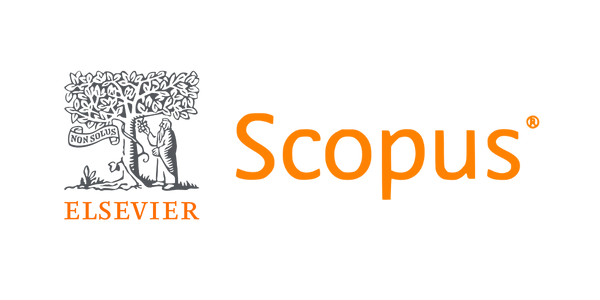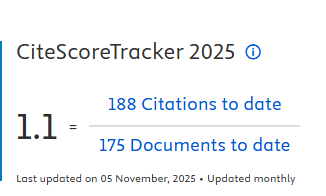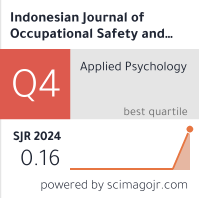Publication Ethics
The Indonesian Journal of Occupational Safety and Health (pISSN 2301-8046 e-ISSN 2540-7872) is a peer-reviewed electronic journal. This statement clarifies the ethical behaviour of all parties involved in the act of publishing an article in this journal, including the author, the chief editor, the Editorial Board, the peer-reviewer and the publisher (Faculty of Public Health, Universitas Airlangga). This statement is based on COPE's Best Practice Guidelines for Journal Editors.
The Indonesian Journal of Occupational Safety and Health is committed to upholding the strictest publication ethics guidelines in order to foster an atmosphere of ethics and responsibility for research. Throughout the publication process, we are dedicated to maintaining integrity, transparency, and ethical conduct in addition to disseminating important knowledge. We have created thorough publication ethics guidelines that adhere to the values set forth by the Committee on Publication Ethics (COPE) in order to be sure of this.
ETHICAL GUIDELINE FOR JOURNAL PUBLICATION
The publication of an article in a peer-reviewed The Indonesian Journal of Occupational Safety and Health (IJOSH) is an essential building block in the development of a coherent and respected network of knowledge. It is a direct reflection of the quality of the work of the authors and the institutions that support them. Peer-reviewed articles support and embody the scientific method. It is, therefore important to agree upon standards of expected ethical behavior for all parties involved in the act of publishing: the author, the journal editor, the peer reviewer, the publisher and the society.
Universitas Airlangga as publisher of The Indonesian Journal of Occupational Safety and Health (IJOSH) takes its duties of guardianship over all stages of publishing extremely seriously and we recognize our ethical and other responsibilities. We are committed to ensuring that advertising, reprint or other commercial revenue has no impact or influence on editorial decisions. In addition, the Faculty of Public Health Universitas Airlangga and Editorial Board will assist in communications with other journals and/or publishers where this is useful and necessary.
DUTIES OF EDITOR
Publication DecisionsThe editor of The Indonesian Journal of Occupational Safety and Health (IJOSH) is responsible for deciding which of the articles submitted to the journal should be published. The validation of the work in question and its importance to researchers and readers must always drive such decisions. The editors may be guided by the policies of the journal's editorial board and constrained by such legal requirements as shall then be in force regarding libel, copyright infringement and plagiarism. The editors may confer with other editors or reviewers in making this decision.
Process ControlEditor must ensure that each manuscript is initially evaluated by the editor for originality, making use of appropriate software to do so. After passing this test, the manuscript is forwarded to one reviewer or more for double-blind peer review, each of whom will make a recommendation to accept, reject, or modify the manuscript. The review period will be given up to 21 days at least but can last up to a month and a half. Editor will send the article to a third reviewer if there is a different decision between the two previous reviewers.
Fair PlayAn editor at any time evaluate manuscripts for their intellectual content without regard to race, gender, sexual orientation, religious belief, ethnic origin, citizenship, or political philosophy of the authors.
ConfidentialityThe editors and any editorial board members must not disclose any information about a submitted manuscript to anyone other than the corresponding author, reviewers, potential reviewers, other editorial advisers, and the publisher, as appropriate.
Disclosure and Conflict of InterestUnpublished materials disclosed in a submitted manuscript must not be used in an editor's own research without the express written consent of the author.
Misconduct
- Research Misconduct: The Editor has the right to reject a submission and notify pertinent parties, including the author's institution and the ethics committee, if there is reason to believe that the research was not carried out ethically. Retraction may occur in the event of demonstrable misbehavior in published works or serious compromise of scientific integrity.
- Data Fabrication and Falsification: Data fabrication is the process of modifying data to create an incorrect impression, like changing pictures or eliminating anomalies. Data creation is the process of inventing study results. Any concerns about data integrity that arise during or after peer review will be directed to the Editor, who may ask to see anonymised underlying data in order to confirm the information. If original data cannot be produced, the work may be rejected or retracted, and the author's institution may be notified of any suspected misconduct.
- Duplicate Publication: Writers have to disclose any possible overlaps or repetitions. Publications that might overlap should be identified and referenced. It was improper for manuscripts to be formally published elsewhere. Manuscripts that are "in press" or have not yet been published should be provided to the editor upon request. The right to evaluate such overlaps on a case-by-case basis is reserved by The Indonesian Journal of Occupational Safety and Health.
- Citations: To substantiate assertions made, both research and non-research pieces must mention pertinent literature. Unsuitable citation techniques are prohibited, including excessive self-citation, author coordination in self-citation, and needless mention of the journal to which the work is submitted.
- Publication Misconduct: The Indonesian Journal of Occupational Safety and Health follows COPE guidelines for handling potential publication misconduct.
Retraction Process
1. Research Misconduct: Articles may be retracted if there is clear evidence of data fabrication, data falsification, plagiarism, or other forms of research misconduct.
2. Significant Errors: Retraction may be considered if the article contains significant errors that substantially affect the overall validity or reliability of the findings.
3. Ethical Concerns: Articles may be retracted if ethical issues such as unethical research practices, conflicts of interest, or violations of human or animal rights are identified.
4. Duplicate Publication: Retraction may be warranted if the article has been previously published elsewhere without proper acknowledgment or justification.
5. Authorship Issues: Retraction may be considered in cases involving serious disputes or inconsistencies regarding authorship or the attribution of work.
Initiating the Retraction Process
6. Retraction Request: Any individual, including authors, readers, or other concerned parties, may formally submit a retraction request to the editor-in-chief or the editorial office. The request should include detailed reasons for retraction and any available supporting evidence.
7. Preliminary Assessment: Upon receipt of a retraction request, the editor-in-chief will conduct an initial assessment to evaluate the validity and seriousness of the issues raised. This process may involve consulting with relevant experts or the journal's editorial board.
8. Notification: If the preliminary assessment determines that the concerns are significant, the corresponding author of the article in question will be informed. They will be given an opportunity to respond to the allegations within a specified timeframe.
Investigation and Decision-Making
9. Investigation: The editor-in-chief, with input from the editorial board and/or external experts, will conduct a thorough investigation into the allegations and evaluate their validity and credibility.
10. Decision-Making: Based on the findings of the investigation, the editor-in-chief will decide on the appropriate course of action. This decision may result in one of the following outcomes:
- No Retraction: If the concerns are found to lack substantiation, the article will remain published with necessary clarifications or corrections.
- Retraction: If the concerns are substantiated and meet the retraction criteria outlined in Section 1, the article will be formally retracted from the journal.
Retraction Process
11. Retraction Statement: A formal statement retracting the article will be prepared. This statement will clearly outline the reasons for the retraction, reference any relevant evidence or investigations, and include identifying information about the article such as its title, authors, and publication date.
12. Publication: The retraction statement will be prominently published, including on the journal's website and alongside the online version of the article. It will be linked to the original article and any associated content to ensure visibility and accessibility. Additionally, the statement will be posted on ANJANI, an integrity platform established by the Indonesian government for reporting academic integrity violations.
13. Communication: The corresponding author and all co-authors of the retracted article will be formally notified of the retraction decision. They will receive a copy of the retraction statement for their records.
Post-Retraction Actions
14. Corrections and Clarifications: If deemed appropriate, adjustments such as corrections or clarifications may be made to other articles or related materials that reference the retracted article. This ensures accuracy and transparency. Modifications to published articles that affect their interpretation and conclusions, without completely nullifying the article, will be addressed through a Correction. Such Corrections will be indexed and linked bidirectionally to the original article, at the discretion of the Editor(s) of The Indonesian Journal of Occupational Safety and Health.
15. Editorial Notes: The journal may opt to publish an editorial note discussing the retraction and its implications for the scientific community, as deemed necessary.
16. Database and Indexing Updates: Steps will be taken to inform databases, indexes, and relevant platforms of the retraction. Necessary updates will be made to accurately reflect the retraction status.
DUTIES OF REVIEWERS
Contribution to Editorial DecisionsPeer review assists the editor in making editorial decisions and through the editorial communications with the author may also assist the author in improving the paper.
PromptnessAny selected referee who feels unqualified to review the research reported in a manuscript or knows that its prompt review will be impossible should notify the editor and excuse himself from the review process.
ConfidentialityAny manuscripts received for review must be treated as confidential documents. They must not be shown to or discussed with others except as authorized by the editor.
Standards of ObjectivityReviews should be conducted objectively. Personal criticism of the author is inappropriate. Referees should express their views clearly with supporting arguments.
Acknowledgement of SourcesReviewers should identify relevant published work that has not been cited by the authors. Any statement that an observation, derivation, or argument had been previously reported should be accompanied by the relevant citation. A reviewer should also call to the editor's attention any substantial similarity or overlap between the manuscript under consideration and any other published paper of which they have personal knowledge.
Disclosure and Conflict of InterestPrivileged information or ideas obtained through peer review must be kept confidential and not used for personal advantage. Reviewers should not consider manuscripts in which they have conflicts of interest resulting from competitive, collaborative, or other relationships or connections with any of the authors, companies, or institutions connected to the papers.
DUTIES OF AUTHORS
Reporting standardsAuthors of reports of original research should present an accurate account of the work performed as well as an objective discussion of its significance. Underlying data should be represented accurately in the paper. A paper should contain sufficient detail and references to permit others to replicate the work. Fraudulent or knowingly inaccurate statements constitute unethical behaviour and are unacceptable.
Data Access and RetentionAuthors are asked to provide the raw data in connection with a paper for editorial review, and should be prepared to provide public access to such data (consistent with the ALPSP-STM Statement on Data and Databases), if practicable, and should in any event be prepared to retain such data for a reasonable time after publication.
Originality and PlagiarismTwo of the most important components of ethical publishing are originality and avoiding plagiarism. It is imperative that all papers submitted to Jurnal Ners be original, never before published, and not currently being considered by another publication. We advise authors to utilize plagiarism detection tools during the review process and to properly credit and reference other authors' work in order to prevent plagiarism.
Multiple, Redundant or Concurrent PublicationAn author should not in general publish manuscripts describing essentially the same research in more than one journal or primary publication. Submitting the same manuscript to more than one journal concurrently constitutes unethical publishing behaviour and is unacceptable.
Acknowledgement of SourcesProper acknowledgment of the work of others must always be given. Authors should cite publications that have been influential in determining the nature of the reported work.
Authorship of the PaperAuthorship should be limited to those who have made a significant contribution to the conception, design, execution, or interpretation of the reported study. All those who have made significant contributions should be listed as co-authors. Where there are others who have participated in certain substantive aspects of the research project, they should be acknowledged or listed as contributors. The corresponding author should ensure that all appropriate co-authors and no inappropriate co-authors are included on the paper and that all co-authors have seen and approved the final version of the paper and have agreed to its submission for publication.
Hazards and Human or Animal Subjects•Ethics Approval and Consent to Participate
-Manuscripts reporting studies involving human participants, human data or human tissue must:
• Include a statement on ethics approval and consent (even where the need for approval was waived)
• Include the name of the ethics committee that approved the study and the committee's reference number if appropriate.
Studies involving animals must include a statement on ethics approval.
See our editorial policies for more information.
If your manuscript does not report on or involve the use of any animal or human data or tissue, this section is not applicable to your submission. Please state "Not applicable” in this section.
•Consent for Publication
-If your manuscript contains any individual person's data in any form (including individual details, images or videos), consent to publish must be obtained from that person, or in the case of children, their parent or legal guardian. All presentations of case reports must have consent to publish. You can use your institutional consent form or our consent form if you prefer. You do not need to send the form to us on submission, but we may request to see a copy at any stage (including after publication). See our editorial policies for more information. If your manuscript does not contain any individual persons data, please state "Not applicable” in this section.
Disclosure and Conflicts of InterestAll authors should disclose in their manuscript any financial or other substantive conflicts of interest that might be construed to influence the results or interpretation of their manuscript. All sources of financial support for the project should be disclosed.
Fundamental errors in published workWhen an author discovers a significant error or inaccuracy in his/her own published work, it is the author's obligation to promptly notify the journal editor or publisher and cooperate with the editor to retract or correct the paper.
Research Registration
IJOSH requires the author to write the research ethics registration number in the methods section of the article and attach the ethics certificate upon submission.







 How to Submit Articles in OJS
How to Submit Articles in OJS

























